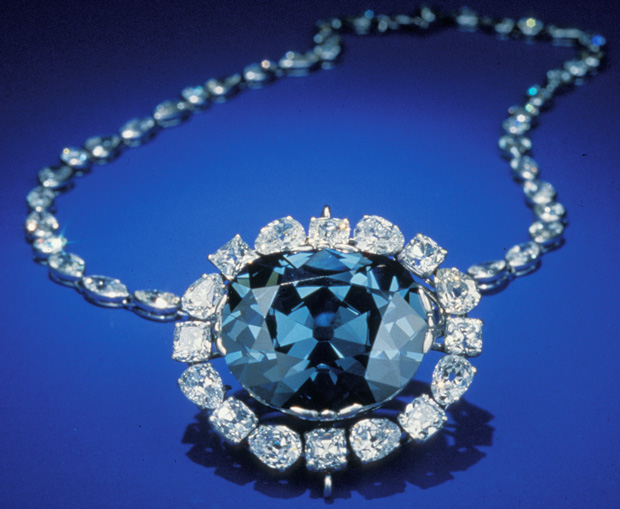The Hope diamond has intrigued people for centuries. Its perfect quality, its large size 45.52 carats (9.10 g), and its rare color (fancy deep blue diamond) make it strikingly unique and beautiful, currently housed in the Smithsonian Natural History Museum in Washington, D.C. The Hope Diamond is blue to the naked eye because of trace amounts of boron within its crystal structure, but it exhibits red phosphorescence under ultraviolet light. It is classified as a type IIb diamond, which are semiconductive and usually phosphoresce. The Hope diamond phosphoresces a strong red color, which will last for several seconds after exposure to short wave ultra-violet light. The first known precursor to the Hope Diamond was the Tavernier Blue diamond, a crudely cut triangular shaped stone of 115 carats (22.44 g) (This diamond was much larger than the present weight of the Hope diamond because the Hope has been cut down at least twice in the past three centuries.) The diamond is believed to have come from the Kollur mine in Golconda, India, and is famous for supposedly being cursed.
The Tavernier Blue named for the French merchant-traveler Jean-Baptiste Tavernier who brought it to Europe. His book, the Six Voyages (Le Six Voyages de...), contains sketches of several large diamonds he sold to Louis XIV in 1669; while the blue diamond is shown among these, Tavernier makes no direct statements about when and where he obtained the stone.
The historian Richard Kurin builds a plausible case for 1653 as the year of acquisition, and an origin from the Kollur mine in Guntur district Andhra Pradesh (a part of the Golconda kingdom), India. The history of the stone which was eventually named the Hope diamond began when Tavernier obtained the blue diamond during one of his five voyages to India between the years 1640 and 1667. While there, he stole a large blue diamond from the forehead (or eye) of a statue of the Hindu goddess Sita, the wife of Rama, the Sixth Avatar of Vishnu. Where it had been set as one of two matching eyes, and the temple priests then laid a curse on whoever might possess the missing stone.
Early in the year 1669, Tavernier sold this blue diamond along with approximately one thousand other diamonds to King Louis XIV of France for 220,000 livres, the equivalent of 147 kilograms of pure gold. There has been some controversy regarding the actual weight of the stone; Morel believes that the 112 3/16 carats stated in Tavernier's invoice would be in old French carats, thus 115.28 metric carats. For this transgression, according to the legend, Tavernier was torn apart by wild dogs on a trip to Russia (after he had sold the diamond).
This was the first horrible death attributed to the curse, but the historical record shows that he actually lived to the age of 84 (it is not known how he died).
In 1678, Louis XIV commissioned the court jeweller, Sieur Pitau, to recut the Tavernier Blue, resulting in a 67 1/8 carat (13.4 g) stone which royal inventories thereafter listed as the Blue Diamond of the Crown (diamant bleu de la Couronne de France,), but later English-speaking historians have simply called it the French Blue. It was set in gold and suspended on a neck ribbon for the King to wear on ceremonial occasions.
Read more on Unsolved Mystery of Hope Diamond (Cursed Diamond)


1 comment:
Great article!
You might be interested in my newly published historical novel, The French Blue. It tells the story of Tavernier's Six Voyages in novel form. More information and articles on Tavernier and the Blue Mystery can be found at http://www.thefrenchblue.com
Post a Comment